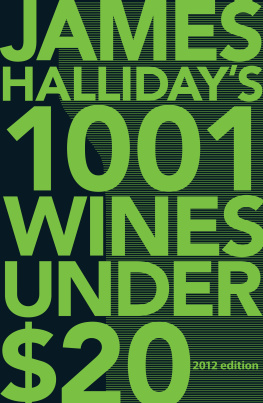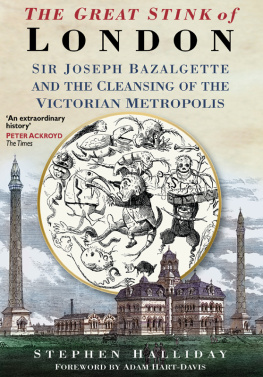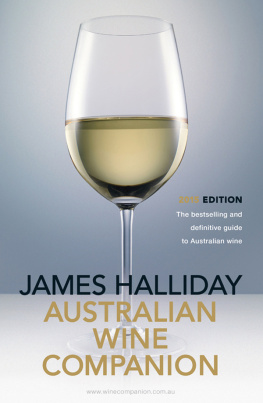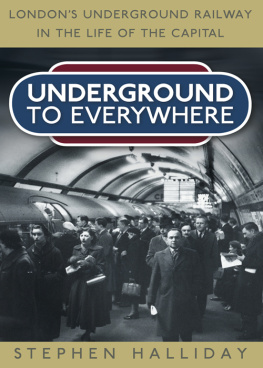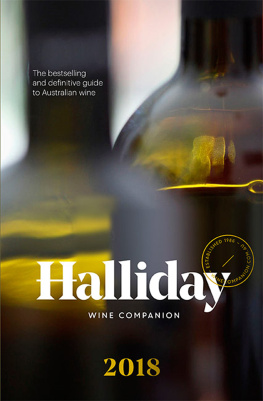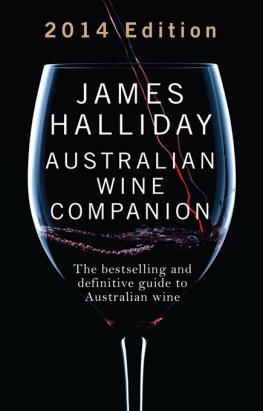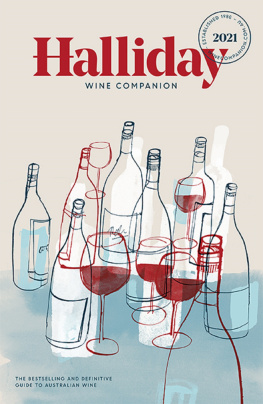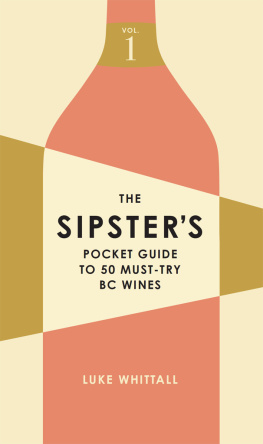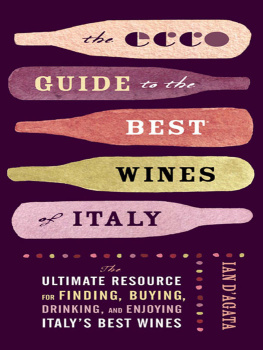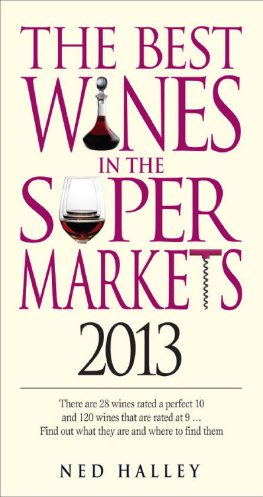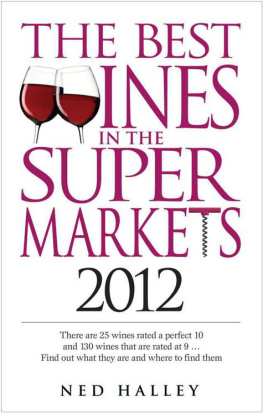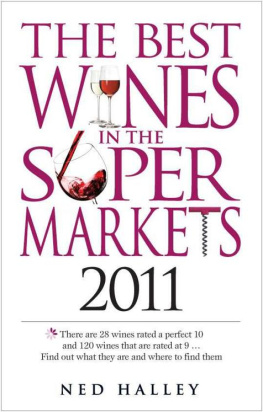Published in 2011 by Hardie Grant Books
Hardie Grant Books (Australia)
Ground Floor, Building 1
658 Church Street
Richmond, Victoria 3121
www.hardiegrant.com.au
Hardie Grant Books (UK)
Dudley House, North Suite
3435 Southampton Street
London WC2E 7HF
www.hardiegrant.co.uk
All rights reserved. No part of this publication may be reproduced, stored in a retrieval system or transmitted in any form by any means, electronic, mechanical, photocopying, recording or otherwise, without the prior written permission of the publishers and copyright holders.
The moral rights of the author have been asserted.
Copyright James Halliday 2011
National Library of Australia Cataloguing-in-Publication entry:
Author: Halliday, James, 1938
Title: 1001 wines under $20 / James Halliday.
ISBN: 9781742702384 (pbk.)
EISBN 978 1 74273 700 3
Notes: Includes index.
Subjects: Wine and wine makingAustralia. WineriesAustralia.
Dewey Number: 641.220994
Project Editor: Foong Ling Kong
Editor: Jean Kingett
Design Manager: Heather Menzies
Typesetter: Megan Ellis
CONTENTS
First, a quick explanation about the way the tasting notes are organised. Each chapter introduces a variety, and the notes are listed in alphabetical order under the name of their winery. If there is more than one vintage for a given wine, the youngest vintage will appear first. They are not entered by points.
Blended wines are principally grouped under the dominant variety in the blend. There is one exception to this: any wine with a percentage of grenache included is listed in the Grenache and Blends chapter (including, of course, 100% grenache wines).
Next is an explanation of the rationale (there is more than one) for the book.
While there are 123 tasting notes that have appeared in the 2012 Wine Companion, more than 500 would, in the normal course, not appear in print, going instead to www.winecompanion.com.au. Each year this cohort will become more numerous as the number of wineries competing for space in the Wine Companion intensifies. In this years book and on the website 1477 appear, while another 1225 are only featured on the website. By definition, none of the wines of the latter wineries appears in the Wine Companion.
This is not an orchestrated move to create a demand for this book. The 2012 Wine Companion has 776 pages, the same as that for the 2011 and 2010 editions. But I have significantly compressed the content since 2010 by only giving full tasting notes for the best wines of each winery. That compression is destined to increase as the years go by.
The second rationale is that there are 323 new vintage notes for wines not released at the time the manuscript of the Wine Companion was finished. Thus there are 88 notes for 2011 vintage wines, and 235 notes for follow-on releases, variously from 2010 and 2009, and a handful older still.
I should also explain the way prices have been treated. Wines sold through retail will almost all finish with 99 cents, whereas cellar door (whether online or physically) usually quote whole dollars. All this comes into special focus with wines selling for $20. If retail they will be shown as $19.99, and thus optically satisfying the under $20 starting post for this book. There was no way I was going to deny a wine with a $20-even price tag a place in this book.
But from there on, the prices shown are those given by the winery. I dont know whether this is an already discounted price, or a starting point. If you shop around, you may well find far lower prices than those quoted in this book.
James Busby was a quite extraordinary man. Born in Scotland on 7 February 1801, he emigrated to the colony of New South Wales with his family in 1824. Before he left Scotland, and with no prior knowledge of viticulture or winemaking, he spent some months in Frances wine regions, learning as much as he could about these activities.
His motivation was the need he perceived for the colony to develop exports that could survive the long sea trip to England and meet existing market demand. He published two books on viticulture and winemaking after his arrival in Sydney, one in 1825, the second in 1830.
Around this time, Gregory Blaxland, the explorer, and Captain John Macarthur, of merino sheep fame, had also obtained and planted vine cuttings, Blaxland sending the first Australian wine to England in 1822, and Macarthur (and his two sons) travelling through Europe collecting vines and planting his first vineyard in 1820. But it was the trip through Spain and France that Busby made in 1831 that was of pivotal importance in the establishment of todays Australian wine industry.
Busby kept a meticulous record of each days travel, and of the vine cuttings he collected on the way. His notes were published in 1833 as Journal of a Tour (and in lesser typeface) through some of the Vineyards of Spain and France. He dedicated the Journal to his father, John, who designed and built Sydneys first system to supply fresh water.
Busbys tour began in Cadiz, Spain, on Monday 26 September 1831 and ended on Thursday 22 December 1831 in A, Champagne (thereafter in Paris). Busbys bible was a list of 570 vines created by the Botanic Garden of Montpellier, and which are listed, one by one, in the Catalogue Third (pages 12638 of the Journal). In fact, only 433 were supplied, and of the missing 137, he obtained 110 from the Luxembourg Gardens in Paris.
Of these, 363 survived the trip to Sydney, packed in moss, sand and soil, and were planted in the Sydney Botanic Gardens. There are numerous gaps in the catalogue, and the names vary from the utterly mysterious (sevent noir, de lHrault; passadoule Bougie), to the intriguing (barbera noir, P; Pineau fleuri, Cte dOr), to the commonplace (grenache, entered several times; pineau noir, Viene; pineau noir de lYonne; and pineau, Cte dOr).
But the most important were listed in the Catalogue First (pages 11220), and were mainly collected by Busby direct from the vineyards, where the owners were usually in attendance. They included (using Busbys spelling) carignan, grenache, mataro, mourastrell, blanquette, muscat, grenache blanche, mcabeo, chasselas and cinque saut, all names easily recognised. Most have been grown in Australia at one time or another or are about to be grown. In the heart of this catalogue are the core varieties of the northern Rhne Valley, Burgundy and Bordeaux, and I have covered these in the wine sections that follow in this book.
It remains to briefly complete James Busbys story. In 1832 he accepted an appointment as British Resident in New Zealand, departing in 1833 with some of the cuttings he had obtained, and accompanied by his wife Agnes.
A house had been built for him at Waitangi, and while his duties as British Resident were to protect British commerce, he quickly became involved in matters of lasting national importance. First, an official New Zealand flag was chosen by Maori chiefs at a meeting in his house on 20 March 1834. In 1835 when he learnt that a French baron was proposing to declare sovereignty over New Zealand, he drafted the Declaration of Independence of New Zealand, signing it with 35 chiefs from the northern part of New Zealand in November of that year. Finally, he coauthored the Treaty of Waitangi that was signed on 5 and 6 February 1840 on the lawn outside his residence.
James Busbys Journal talks of 389 Rischling, Bas-Rhin cuttings, leaving no doubt about the identity of the variety. While it was planted in the Hunter Valley, in what today is known as the Canberra District, and elsewhere in New South Wales, riesling largely bypassed Victoria, and found its home away from home in South Australia. Joseph Gilbert was a noted South Australian vigneron, his Pewsey Vale rieslings of 1852 and 1854 winning high praise.

